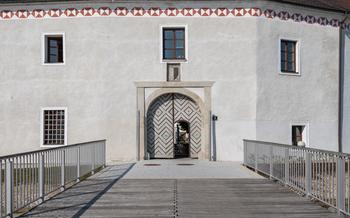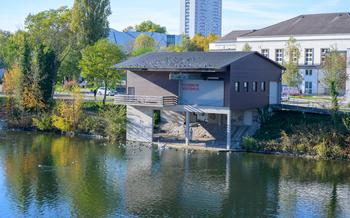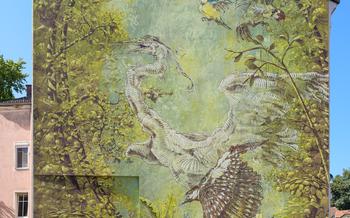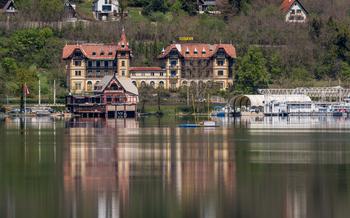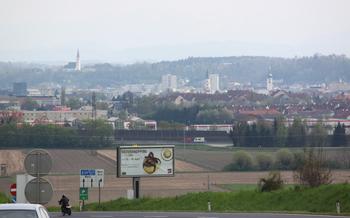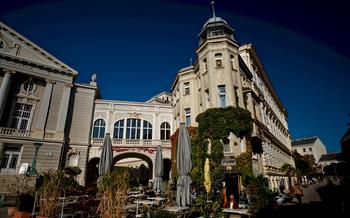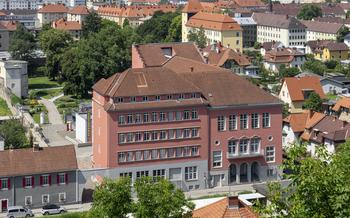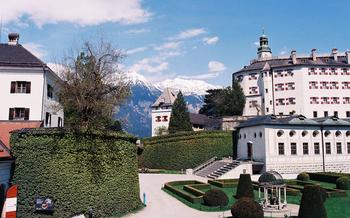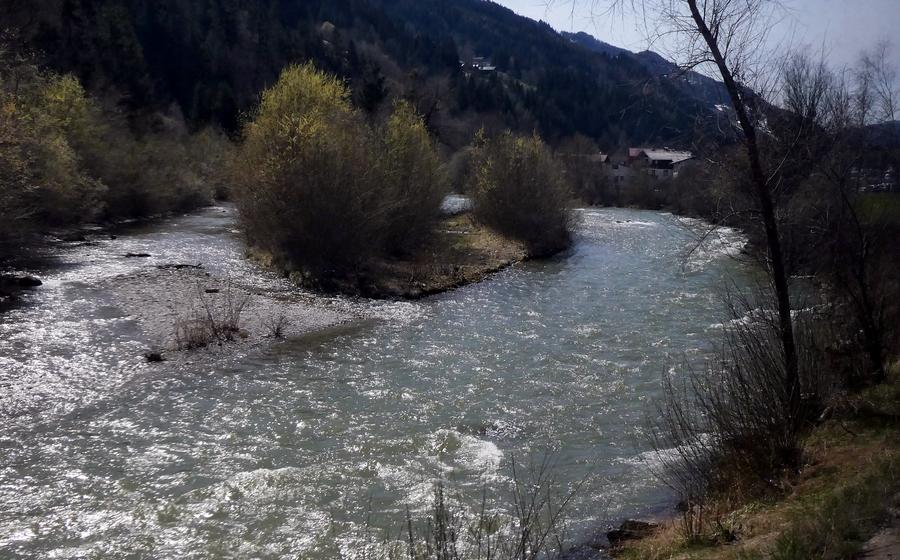
Kremsmünster Abbey
- Historical Significance
- Architectural Masterpiece
- Unique Astronomical Tower
- Magnificent Interiors
- Sacred Spaces
- Imperial Treasury
- Guided Tours
- Seasonal Events
- How to Get There
- Where to Stay
- What to Eat
- Insider Tip: Unveiling the Hidden Tapestry
Historical Significance
In the heart of Upper Austria, along the picturesque banks of the Krems River, stands the magnificent Kremsmünster Abbey, a testament to centuries of faith, scholarship, and architectural grandeur. Founded in 777 AD by Duke Tassilo III of Bavaria as a Benedictine monastery, Kremsmünster Abbey holds a prominent place in Austrian history. Throughout the centuries, it has been a center of religious devotion, intellectual inquiry, and cultural preservation, leaving an indelible mark on the region's spiritual and cultural landscape.
Despite undergoing renovations and modernizations over the years, Kremsmünster Abbey has meticulously preserved its historical identity. It remains a living embodiment of its Benedictine heritage, where the traditions of the past seamlessly blend with contemporary practices, creating a unique and awe-inspiring experience for visitors.
Architectural Masterpiece
The Kremsmünster Abbey stands as a testament to the architectural prowess of its builders. Its Romanesque and Gothic influences blend seamlessly, creating a harmonious fusion of styles. The twin towers, reaching skyward, dominate the abbey's facade, their intricate carvings narrating tales from the past. The grand entrance, adorned with delicate sculptures, invites visitors into a world of artistic splendor. Inside, the intricate ribbed vaults, supported by slender columns, create a sense of awe and grandeur. The delicate tracery of the Gothic windows casts a soft, ethereal glow, illuminating the ornate ceiling paintings. The intricate details of the abbey's architecture, from the finely crafted choir stalls to the delicate frescoes, reflect the dedication and artistry of its creators.
The abbey's restoration efforts have been meticulous and painstaking, ensuring that its architectural integrity remains intact. Over the centuries, the abbey has undergone several renovations, each respecting its original design and preserving its historical essence. The result is a building that stands as a testament to the enduring power of architectural heritage, a masterpiece that continues to inspire and captivate visitors from around the world.
Unique Astronomical Tower
In the 17th century, the abbey embarked on an ambitious project, constructing an astronomical tower that would become a significant landmark. Standing tall and majestic, the tower served as an observatory, equipped with advanced instruments for celestial observations. Astronomers and scientists meticulously charted the movements of stars and planets, pushing the boundaries of scientific knowledge. Through their dedication and meticulous observations, they contributed to the understanding of the cosmos and laid the groundwork for future scientific advancements. The tower's legacy continues to inspire awe and wonder among visitors, who marvel at the ingenuity and precision of the instruments used by the pioneering astronomers of Kremsmünster Abbey.
Magnificent Interiors
Step inside the abbey and prepare to be awestruck by its opulent interiors, a testament to centuries of artistic and religious devotion. The grand entrance hall welcomes you with its soaring ceilings and intricate frescoes, each brushstroke narrating a chapter from the abbey's storied past. Admire the intricate ceiling paintings that adorn the main hall, a symphony of colors and biblical scenes that transport you to a realm of divine inspiration.
Stained glass windows, like vibrant tapestries woven from light, cast a celestial glow upon the abbey's interior. Each window tells a tale, depicting saints, angels, and biblical events with exquisite detail and artistry. The play of light through these stained glass masterpieces creates an ethereal atmosphere, inviting contemplation and a sense of spiritual connection.
Sacred Spaces
At the heart of Kremsmünster Abbey lies the grand basilica, a testament to the spiritual essence of this Benedictine monastery. Step inside, and you'll be awestruck by the soaring arches, intricate carvings, and ornate altars that adorn this sacred space. The basilica's design is a harmonious blend of Romanesque and Gothic elements, creating an atmosphere of both grandeur and reverence.
The high altar, a masterpiece of Baroque artistry, takes center stage, adorned with intricate sculptures, delicate carvings, and gleaming gold leaf. It's a testament to the abbey's dedication to craftsmanship and its commitment to creating a space worthy of divine worship.
Throughout the basilica, you'll find chapels dedicated to various saints and adorned with stunning frescoes and stained glass windows. Each chapel tells a story, depicting scenes from the Bible or the lives of the saints. The stories come to life through the vibrant colors and expressive brushstrokes, inviting visitors to contemplate the deeper spiritual meanings behind the artwork.
In the midst of all this splendor, there's a sense of peace and tranquility that permeates the air. It's a place where the soul can find solace, where the faithful can come together in prayer, and where visitors can experience the awe-inspiring presence of the divine.
Imperial Treasury
Nestled within the hallowed halls of Kremsmünster Abbey lies a treasure trove of invaluable artifacts, the Imperial Treasury. This extraordinary collection houses a mesmerizing array of relics, precious objects, and ecclesiastical masterpieces that bear witness to the abbey's rich history and profound cultural significance.
Among the most revered relics are fragments of the True Cross, believed to be a part of the cross upon which Jesus Christ was crucified. These sacred fragments are enshrined in an exquisitely crafted reliquary, adorned with intricate goldsmith work and shimmering gemstones.
The treasury also boasts an impressive collection of liturgical objects, including ornate chalices, monstrances, and processional crosses. Each piece is a testament to the skill and artistry of master craftsmen, showcasing their meticulous attention to detail and profound devotion.
One of the highlights of the collection is the Imperial Crown of Austria, a symbol of power and sovereignty. This magnificent crown, adorned with precious stones and intricate goldsmith work, was once worn by the Holy Roman Emperors during their coronation ceremonies.
The Imperial Treasury is a testament to the abbey's enduring legacy as a center of spiritual and cultural heritage. It invites visitors to delve into the depths of history, marvel at the exquisite craftsmanship, and experience the profound reverence that surrounds these treasured artifacts.
Guided Tours
Kremsmünster Abbey offers a comprehensive guided tour program, allowing visitors to explore its rich history, architecture, and spiritual significance. These tours are conducted in multiple languages, ensuring accessibility for visitors from diverse backgrounds. Taking a guided tour is highly recommended, as it provides invaluable insights into the abbey's past and present, enhancing the overall visitor experience.
Knowledgeable and passionate guides lead the tours, sharing fascinating stories and anecdotes about the abbey's founding, its role in the Benedictine order, and its contributions to science, art, and culture. Visitors will gain a deeper understanding of the intricate details of the abbey's architecture, including the Romanesque and Gothic styles, as well as the significance of the twin towers and elaborate facade.
Guided tours typically last around 60 to 90 minutes, providing ample time to explore the abbey's highlights, including the grand entrance hall, the magnificent basilica, and the impressive library. Visitors will have the opportunity to ask questions and engage in discussions with the guides, enriching their understanding of the abbey's history and significance.
To ensure a memorable and informative visit, it is advisable to book a guided tour in advance, especially during peak tourist season. Information on tour schedules and booking procedures can be found on the abbey's official website or by contacting the visitor information center.
Seasonal Events
Kremsmünster Abbey comes alive with a variety of cultural and religious events throughout the year, offering visitors a chance to experience its rich traditions and festive atmosphere.
One of the most popular events is the Christmas market, held annually in the abbey's courtyard. Here, visitors can browse stalls selling handmade crafts, local delicacies, and festive decorations while enjoying traditional music and entertainment.
The abbey also hosts regular concerts, featuring talented musicians and ensembles performing classical, sacred, and contemporary music within the abbey's magnificent basilica or in the historic concert hall.
For those interested in history and culture, the abbey organizes special exhibitions and lectures throughout the year, showcasing its extensive collection of artifacts, manuscripts, and artwork.
During the summer months, visitors can attend the Kremsmünster Summer Festival, which features a variety of outdoor concerts, theater performances, and family-friendly activities set amidst the abbey's beautiful gardens.
To make the most of your visit, check the abbey's website or contact the tourist office for information on upcoming events and how to participate.
How to Get There
Reaching Kremsmünster Abbey is a breeze, with multiple transportation options available. For those who prefer public transit, buses and trains offer convenient connections from nearby cities and towns. Check the local transit schedules to plan your journey accordingly.
If you're driving, the abbey is easily accessible by car. Ample parking facilities are available for visitors, ensuring a hassle-free experience. Simply follow the road signs or use a navigation app to guide you to the abbey's designated parking areas.
No matter your preferred mode of transportation, getting to Kremsmünster Abbey is a straightforward and enjoyable experience, allowing you to embark on your exploration of this architectural and spiritual gem without any worries.
Where to Stay
For those seeking a comfortable and immersive stay, numerous accommodation options are available in the vicinity of Kremsmünster Abbey. Visitors can choose from charming hotels, cozy guesthouses, and traditional inns that exude the region's rich history and culture. Staying close to the abbey offers the convenience of exploring its wonders and participating in various events without the need for extensive travel.
Many hotels provide modern amenities, elegant rooms, and stunning views of the abbey or the surrounding landscapes. For those seeking a more intimate experience, guesthouses offer a warm and welcoming atmosphere, often run by local families who share their knowledge and insights about the region. Traditional inns, with their rustic charm and historic ambiance, provide a unique opportunity to immerse oneself in the local way of life.
When selecting accommodation, consider factors such as proximity to the abbey, desired amenities, and budget. Advance booking is recommended, especially during peak tourist seasons or for special events, to secure the best options. Whether seeking a luxurious stay or a cozy retreat, the area surrounding Kremsmünster Abbey offers a range of choices to suit every traveler's needs and preferences.
What to Eat
When visiting Kremsmünster Abbey, immersing yourself in the local culinary delights is a must. The region is renowned for its traditional Austrian cuisine, which boasts hearty dishes that reflect the region's rich agricultural heritage.
For a truly authentic experience, venture into the charming town of Kremsmünster and seek out one of the traditional Gasthäuser (inns) or gemütliche (cozy) cafes. Here, you can savor local specialties such as Knödel (dumplings) served with various sauces, hearty Tafelspitz (boiled beef) accompanied by horseradish and chives, or the classic Wiener Schnitzel, a breaded veal cutlet served with potato salad and lingonberry jam.
Don't forget to indulge in the region's delectable pastries and desserts. The local bakeries offer an array of tempting treats, including the famous Linzer Torte, a lattice-topped tart filled with red currant jam, or the Salzburger Nockerl, a fluffy soufflé-like dessert served with powdered sugar.
To enhance your culinary journey, consider joining a guided food tour or workshop. These experiences offer the opportunity to learn about the region's culinary traditions, sample local delicacies, and even try your hand at preparing some of the dishes yourself.
Remember, food is an integral part of any travel experience. By savoring the local flavors, you can gain a deeper appreciation for the culture and heritage of Kremsmünster and its surroundings.
Insider Tip: Unveiling the Hidden Tapestry
Venture beyond the abbey's grand facade and discover a hidden gem that will transport you back in time. Tucked away in a secluded corner of the abbey grounds, a centuries-old tapestry depicting the abbey's rich history awaits your exploration. This masterpiece, woven with intricate detail and vibrant colors, offers a glimpse into the abbey's past, capturing moments of devotion, celebration, and everyday life.
To find this hidden gem, seek the abbey's oldest monk, Brother Anselm, who holds the key to unlocking the hidden chamber where the tapestry resides. He will guide you through the abbey's secret passageways, revealing hidden doors and forgotten corners before unveiling the awe-inspiring tapestry. Prepare to be captivated by the stories woven into each thread, a testament to the abbey's enduring legacy.

